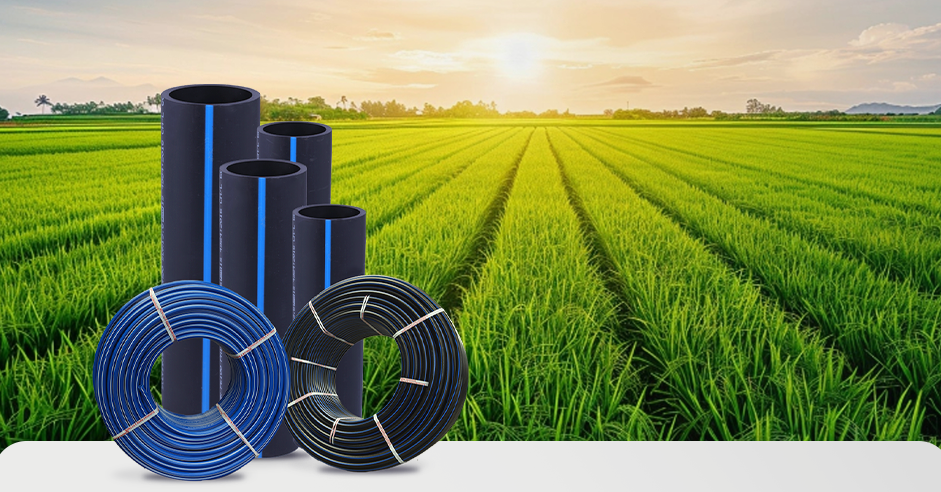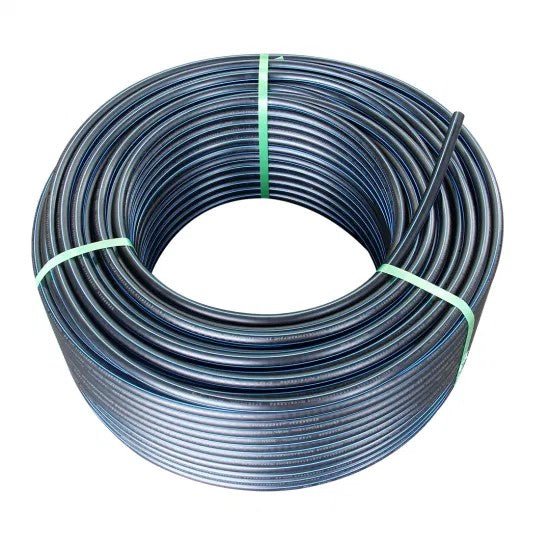hdpe pipe suppliers Midland TX: Checklist for Contractors
Discover the Production Refine Behind High-Quality HDPE Pipeline and Its Applications
The manufacturing process of top quality HDPE pipelines is elaborate and systematic. It starts with the option of basic materials that improve efficiency. Following this, ethylene goes through polymerization to form resin, which is then shaped through extrusion. Quality control is extremely important, making sure that the final item fulfills rigorous requirements. However, the journey of HDPE pipes doesn't finish with manufacturing. Their applications throughout numerous sectors reveal a broader significance worth checking out.
Understanding HDPE: Properties and Advantages

High-density polyethylene (HDPE) is a versatile polycarbonate understood for its resilience and resistance to various ecological variables. This material displays excellent tensile stamina, making it appropriate for requiring applications. Its low-density framework adds to a lightweight product, facilitating convenience of handling and setup. HDPE likewise showcases amazing resistance to chemicals, which reduces degradation when subjected to severe substances.
The material's low wetness absorption better boosts its durability, making it excellent for use in pipes and storage containers. Additionally, HDPE is immune to ultraviolet (UV) radiation, making certain that items maintain their honesty even when exposed to sunshine. Furthermore, its adaptability enables the production of intricate shapes without jeopardizing toughness. The environmentally friendly nature of HDPE, frequently originated from recycled products, includes to its allure, promoting lasting techniques in production. Generally, these residential or commercial properties and advantages make HDPE a favored selection for different commercial and consumer applications.
Resources Selection for HDPE Manufacturing
The selection of resources for HDPE manufacturing is important to verify the last product meets the preferred requirements and quality requirements. High-density polyethylene (HDPE) is mostly produced from polymerized ethylene, stemmed from nonrenewable fuel sources such as gas or unrefined oil. The high quality of these feedstocks substantially influences the mechanical and thermal residential or commercial properties of the last HDPE.
Additives additionally play a significant function in improving HDPE's performance, consisting of anti-oxidants, UV stabilizers, and colorants, which enhance sturdiness and resistance to environmental aspects. The selection procedure should think about not just the chemical make-up of the raw materials however likewise their handling qualities to guarantee efficient production.
The sourcing of raw materials ought to focus on sustainability and compliance with environmental guidelines, as liable techniques are essential in today's market. Eventually, careful basic material option lays the foundation for creating high-grade HDPE pipes suitable for diverse applications.
The Extrusion Process: Forming HDPE Pipeline
The extrusion procedure plays an essential duty fit HDPE pipes, starting with meticulous material preparation strategies that assure perfect flow and uniformity. Similarly crucial is the style of the die, which straight affects the final dimensions and surface area quality of the pipeline. Together, these elements add greatly to the efficiency and quality of HDPE pipe manufacturing.
Product Preparation Techniques
Reliable manufacturing of HDPE pipelines begins with meticulous product preparation methods, particularly the extrusion procedure. Throughout this stage, high-density polyethylene material is very first dried out to eliminate wetness, making sure perfect circulation attributes. The material is after that fed into the extruder, where it goes through heating and melting, transforming into a thick state. This home heating process is carefully managed to preserve the product's honesty and efficiency. The molten HDPE is required via a die, forming it right into a constant pipeline type. Proper temperature level administration during extrusion is essential, as it directly influences the material's homes and the final item high quality. When find more shaped, the HDPE pipeline is cooled and cut to specified sizes, ready for subsequent handling and applications.
Die Layout Significance
Precision in die design plays a vital duty in the extrusion process of HDPE pipelines. The die acts as the last shaping tool, directly influencing the pipe's dimensions, wall surface density, and surface finish. A well-designed die warranties consistent product flow, decreasing defects such as abnormalities and weak spots. The geometry of the die need to be maximized to fit the specific homes of HDPE, including its viscosity and thermal habits during extrusion. Additionally, the cooling price of the material as it passes with the die can considerably impact the pipe's architectural honesty. Spending in advanced die modern technology is essential for suppliers aiming to generate top notch HDPE pipes that satisfy industry standards and consumer expectations.
Quality Assurance Procedures in HDPE Production
Numerous factors influence the high quality of HDPE pipeline production, efficient top quality control measures are crucial to ensure uniformity and integrity in the final product (hdpe pipe suppliers Midland TX). Secret top quality control techniques include rigorous material evaluation, verifying that the raw polyethylene fulfills established standards for purity and density. During the extrusion procedure, specifications such as temperature level, stress, and cooling time are very closely kept an eye on to preserve dimensional accuracy and structural honesty
In addition, post-production testing is vital; makers commonly try these out conduct hydrostatic tests to evaluate the pipe's strength and resistance to pressure. Visual evaluations for surface defects additionally boost quality control. Qualification from pertinent standards companies, like ASTM or ISO, gives an extra layer of credibility. By applying these detailed quality assurance procedures, suppliers can reduce flaws, boost efficiency, and make certain that the HDPE pipes meet the particular needs of different applications, ultimately bring about consumer contentment and rely on the product.
Applications of HDPE Pipeline Throughout Industries
HDPE pipes are made use of across numerous fields as a result of their durability and versatility. In water distribution systems, they ensure efficient distribution, while in wastewater management, they supply trustworthy remedies for waste transport. In addition, agricultural irrigation networks take advantage of HDPE's resistance to corrosion and versatility, making it a perfect selection for contemporary farming practices.

Water Circulation Solutions
A significant number of industries count on high-density polyethylene (HDPE) pipelines for efficient water circulation systems. Understood for their longevity and resistance to rust, HDPE pipelines are widely made use of in metropolitan water system networks, agricultural irrigation, and commercial applications. Their light-weight nature assists in very easy handling and installment, minimizing labor expenses and time. In addition, HDPE pipes can fit various stress levels, making them appropriate for both reduced and high-pressure systems. American Plastics HDPE Pipe for Oilfield. The versatility of the product allows for seamless combination into existing framework, minimizing the need for substantial excavation. Furthermore, HDPE's resistance to chemical leaching assurances that the water provided stays risk-free and clean, making it a perfect option for preserving the high quality of drinkable water throughout numerous industries
Wastewater Management Solutions
Efficient water circulation systems also lead the way for cutting-edge wastewater management remedies, where high-density polyethylene (HDPE) pipes play a significant duty. Renowned for their longevity and resistance to rust, HDPE pipelines are perfect for carrying wastewater in various settings. Their versatility permits for simple setup in complicated settings, minimizing the requirement for comprehensive excavation. Furthermore, HDPE's smooth indoor surface area decreases rubbing, enhancing flow prices and performance. These pipelines are also resistant to chemical leaching, making sure that impurities do not endanger the surrounding atmosphere. Industries, municipalities, and treatment facilities progressively count on HDPE pipes for their dependability and long life, making them a recommended selection for contemporary wastewater monitoring systems. This flexibility emphasizes the critical importance of HDPE pipes across numerous applications.
Agricultural Irrigation Networks
Agricultural irrigation networks profit greatly from using high-density polyethylene (HDPE) pipes, which supply effective and dependable water shipment to crops. HDPE pipes are lightweight, making them very easy to transfer and install, while their flexibility allows for various arrangements in varied terrains. These pipes show outstanding resistance to rust, chemicals, and UV radiation, guaranteeing toughness in extreme farming settings. In addition, their smooth indoor surface minimizes rubbing loss, optimizing water circulation and reducing power costs related to pumping. The long life of HDPE pipes, typically going beyond half a century, adds to decrease maintenance and substitute costs. Farmers progressively count on HDPE pipes to boost watering effectiveness and advertise lasting agricultural techniques, inevitably leading to enhanced plant returns and resource preservation.

Future Fads in HDPE Pipeline Technology
As the need for sustainable and reliable framework grows, advancements in HDPE pipeline technology are positioned to change different sectors. Emerging check this fads include the integration of clever technologies, such as sensing units and IoT capabilities, which promote real-time tracking of pipeline conditions, lowering maintenance expenses and stopping leakages. Additionally, the growth of advanced production techniques, such as 3D printing, is allowing the manufacturing of complex, tailored pipe styles that deal with particular job requirements.
The emphasis on recycling and round economic climate techniques is driving the technology of HDPE pipes made from recycled materials, improving sustainability. Boosted jointing methods, such as electro-fusion and mechanical fittings, are also improving installment efficiency and reliability. The growing emphasis on environmental regulations is pushing producers to embrace greener production procedures, guaranteeing that HDPE pipelines not just fulfill market requirements yet also cultivate an even more sustainable future for infrastructure development.
Frequently Asked Inquiries
Exactly How Does HDPE Compare to Other Plastic Products?
HDPE outmatches several various other plastic products relating to durability, chemical resistance, and adaptability. Its reduced density and high tensile toughness make it excellent for different applications, commonly surpassing alternatives in both performance and long life.
What Are the Environmental Impacts of HDPE Manufacturing?
The environmental influences of HDPE production include greenhouse gas exhausts, energy usage, and prospective pollution from making processes. In addition, improper disposal can lead to dirt and water contamination, raising worries concerning lasting environmental results.
Can HDPE Pipeline Be Reused?
Yes, HDPE pipes can be reused. Lots of centers accept utilized HDPE for processing, changing it into brand-new items. This recycling adds to sustainability initiatives, decreasing plastic waste while conserving resources and power in the manufacturing cycle.
What Is the Life Expectancy of HDPE Pipes?

Just How Do Temperature Variations Impact HDPE Pipeline Performance?
Temperature level variations significantly influence HDPE pipeline performance, influencing flexibility and stamina. High temperature levels can cause softening, while reduced temperatures may trigger brittleness, inevitably influencing the pipeline's sturdiness and viability for numerous applications in varied atmospheres.